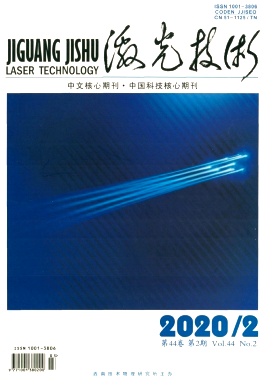HTML
-
我国的能源结构具有以煤为主的特点,煤炭消费在我国能源消费中处于主体地位。从长期来看,煤炭仍然会是我国能源消费的主力。煤中C元素的检测分析可为煤的筛选以及无污染化处理提供指导,对节能、环保方面有着非常重要的意义。激光诱导击穿光谱(laser-induced breakdown spectroscopy, LIBS)技术是一种原子发射光谱技术,它利用低能脉冲激光和聚焦透镜将样品表面极少量的样品蒸发,进而产生等离子体,对获取的光谱数据通过算法分析得到对应的元素成分以及含量,该方法无需经历冗长繁琐的样品预处理过程,无论是固体[1-2]、液体[3-4]还是气体[5-6]均可以实现快速、准确的检测,因此在环境[7]、冶金[8-9]、农业[10]、生物安全[11-12]等领域有着广泛的应用。
LIBS定量分析煤中碳元素方法并不成熟,需要发展长期稳定的定量分析方法。YIN等人在获取到煤样品的光谱数据后,进行了积分计算、归一化、筛选等一系列计算操作,将外界因素以及煤自身性质等因素的影响降到了最低,分析的精确度也得到了大幅提升,但对数据筛选的过程相对繁琐[13]。LI等人将偏最小二乘(partial least squares,PLS)和基于显性因子的PLS方法应用对烟煤中碳元素的检测,结果表明,PLS模型可以获得良好的测量精度,但获取最佳光谱数据需要使用266nm的激光辐射器,这使得在实际中难以实现[14]。QIAN等人将LIBS技术应用于煤质分析,探究355nm,532nm,1064nm 3种不同激光波长的激光对于测量煤样品的影响,得出532nm激光波长最适合于煤中碳元素的检测,但实际中同样面临激光器难以定制的困难[15]。YAO等人利用峰值强度定标法以及强度比定标法完成了对混合样品中的碳质量分数,可以在一定程度上提高定标曲线的拟合度,但是分析结果与碳元素的空间分布有关,相对误差较大[16]。LIU等人通过内标法定量分析烟煤煤粉样品中的碳元素质量分数,结果表明煤粉测量误差可以有效被缩减,但标准样品是通过化学试剂混合制备的,很难精确还原煤中各元素的真实分布[17]。ZHANG等人通过优化等离子体温度和次量元素谱线强度校准系数,建立了一种性能更优的自由定标模型,但等离子温度的计算以及谱线强度的选择相对困难[18-19]。而人工神经网络(artificial neural networks, ANN)的兴起为LIBS定量分析物质提供了新的思路。BI等人用LIBS技术结合ANN方法完成了对矿物的分类与鉴别,结果表明,此方法在研究元素组成和结构特征时有明显的优越性[20]。SUN等人采用LIBS技术获取不同品种钢的光谱数据之后,将数据进行特殊处理后输入至神经网络中,并对其中Mn、Si元素进行了定量分析,得出该方法能对光谱中影响定量分析的信息进行自动的提取和删除,从而得到更优的分析性能[21]。目前采用神经网络算法对煤中碳元素定量分析的研究工作相对较少。
本文中采用激光诱导击穿光谱技术对煤中的C元素进行检测,分别使用基本定标法以及神经网络算法建立C元素的定标曲线,通过对比定标曲线的性能优劣,验证神经网络算法可以有效降低光谱强度的波动性且减小基体效应的影响。
-
实验中使用美国TSI公司的CHEMREVAL台式LIBS激光诱导击穿光谱仪,这是一种集成式一体化的激光诱导击穿光谱仪,具有操作简单灵活、灵敏度高、较短时间便可得到分析结果等优点。激光器采用法国Quantel公司的Nd:YAG激光器,最大重复频率10Hz,最大能量200mJ/脉冲,波长1064nm,聚焦后光斑尺寸为10μm~500μm,分析深度为1μm~100μm;光谱仪采用荷兰Avantes公司的七通道宽幅光谱仪,光谱范围为190nm~950nm,光谱分辨率为0.1nm。实验装置如图 1所示。
实验中所使用的煤样品来自济南泉东标准物质研究所,共计14组样品,随机选择其中的10组样品用于建立碳元素定量分析模型。剩余的4组样品用于验证模型的准确度。所选煤样品的国家标准编号以及碳元素标准质量分数如表 1所示。
sample number mass fraction of carbon 110026 0.6498 110027 0.7160 110028 0.7565 110029 0.7742 110030 0.7518 110031 0.8132 110032 0.6015 110033 0.5708 110034 0.7355 110035 0.7709 110036 0.7823 110038 0.6475 110039 0.7265 110040 0.7710 Table 1. Coal standard samples
首先取10g煤粉搅拌均匀,放置于压力为15MPa的液压机下,压制成直径为32mm的煤片。设置激光器脉冲能量为180mJ,重复频率5Hz,透镜距离样品的高度41.39mm,聚焦后光斑尺寸大小10μm。设置采集延迟时间6μs,以消除等离子体形成初期轫致辐射产生的背景噪声对光谱信号的影响;每次获取光谱数据前,对样品表面发射一束激光脉冲进行清洗,以避免表面不纯物质对实验结果的影响。为避免外部环境因素以及煤片不均匀对实验结果造成的影响,分别每个煤片表面的5个不同位置分别测量5次,即样品最终的光谱图是25次激光作用下的平均结果。
-
标准煤样品在波长范围为188nm~200nm的LIBS光谱如图 2所示。由图 2可知,在波长193.09nm处有明显的特征峰值,且附近没有其它元素谱线的干扰。对比美国NIST原子光谱数据库可知,波长193.09nm处为碳原子独有的特征谱线,选择这条特征谱线来研究C元素浓度与谱线强度之间的关系。
-
当利用LIBS进行定量分析时,标准样品定标法是最为常见的方法。首先使用LIBS技术对标准样品进行击穿,获取各个样品中不同元素特征谱线的强度,然后以某种元素的标准质量分数值作为横坐标,该元素某一特征波长处的谱线强度作为纵坐标,对数据进行拟合,从而得到该元素的定标曲线和定标方程。当验证模型准确程度时,将验证样品的特征谱线强度值带入定标方程,测得验证样品质量分数,进而判断定标模型的准确性。
已知特征谱线强度值与待测元素浓度符合赛伯罗马金公式,可表示为:
式中, I为所测的光谱强度;w为元素质量分数;a为比例常数,其值取决于激发条件,如分析元素进入激发区的数量、干扰元素的影响等;b为自吸收系数,其取值范围为0.5~1。当质量分数w较小时,b≈1;随着w的增大,b逐渐减少到0.5。整个分析过程以C Ⅰ 193.09nm为分析谱线,选择样品110026, 110030, 110031, 110032, 110033, 110034, 110036, 110038, 110039, 110040建立定标模型。为了提高定量分析的精度,将尽可能多影响定标结果的光谱信息用于计算,这里谱线相对强度用峰值面积来表示,即选择特征波长附近区域的积分阴影面积减去两端背景信号所占面积。假设在波长i nm处待测元素特征谱线强度值为Xi,选定i nm波长附近0.4nm范围,根据Trapezoidal积分法,用于计算的峰值部分面积Iy可表示为:
可先计算出C元素谱线两端指定波长范围内波动趋势较为平缓光谱段的平均强度,再将两者取算术平均,表示背景噪声信号的强度,这里在C元素谱线的左端选择波长范围为191.5nm~192nm的光谱数据a,右端选择波长范围为194nm~194.5nm的光谱数据b。如此一来,整个阴影部分中由背景噪声信号主导的面积Ib就可以表示为:
根据(2)式和(3)式,即可得C元素谱线的发射强度(峰值面积):
以样品110039为例,谱线积分强度计算示意图如图 3所示。
当确定10种样品的谱线积分强度后,以谱线相对积分强度为横轴,元素标准质量分数为纵轴,使用赛伯罗马金公式对样品光谱数据进行线性拟合,基本定标曲线结果如图 4所示。
由图 4可知,当使用基本定标法时,定标曲线的拟合度R2=0.84。表 2为基本定标曲线对验证样品的预测结果。其中110027的相对误差为15.05%,110028的相对误差为22.56%,110029的相对误差为14.78%,110037的相对误差为9.16%, 其平均相对误差为15.39%。由于煤的受基体效应的影响大,即使碳元素质量分数相对较高,使用基本定标法仍难以对煤样品中的碳元素实现准确的预测。
sample number true mass fraction the predicted mass fraction relative error/
%110027 0.7160 0.6082 15.05 110028 0.7565 0.5858 22.56 110029 0.7742 0.6598 14.78 110037 0.6498 0.7093 9.16 Table 2. Prediction results of coal validation samples using basic calibration curve method
-
人工神经网络在对未知数据进行非线性拟合时效果优势明显。神经网络算法的核心思想是误差反向传播定理(back propagation,BP),通过不断地更新权值参数来减小误差,网络的中间层参量、学习率可以被任意指定,可以完成对任意维度的参量进行训练,因此物质分类以及克服基体效应方面展现出杰出的性能。在本实验中,样品虽然均是煤,但是其中C, H, O, N, S以及挥发分、灰分等质量分数有较大的区别。基体效应的存在使得难以用基本定标法完成准确的定量分析,因此使用神经网络算法来对复杂成分的物质完成定量分析。BP神经网络在绝大多数情况下由输入层、可根据实际情况灵活更改数量的隐含层以及输出层组成,其基本结构如图 5所示。
当利用BP神经网络算法对煤样品光谱分析数据进行定量分析时,若将整体光谱数据共12248个点作为输入变量,绝大部分输入变量与分析目标无相关性,模型的复杂度会以指数级别上升,网络训练变得异常困难,同时效果变差。光谱信息中每个点对于物质的定量分析均有不同程度的影响,一般来说,与待测元素的特征波长相隔越远,对待测元素定量分析的影响就越小。而若仅仅将待测元素特征波长处的峰值强度作为神经网络的输入,则与之有较大相关性的光谱信息也会被忽略。因此, 选择合适的网络输入可将有用的光谱信息尽可能保留,同时也避免了数据的冗余。实际情况下,进行实验的煤样品种类稀少,使用全光谱数据信息容易导致过拟合。煤中的H, N元素质量分数很低,同时激光诱导击穿煤样品时会击穿空气中的氮气以及少量水蒸气进而影响N, H元素的光谱强度,因此, 难以利用煤中所含其它元素谱线的强度来完成对碳元素更准确的分析。
神经网络在设计过程中需要对网络的结构和参量进行优化。本文中通过Keras框架构建神经网络结构。经过调节参量,得出第一隐藏层的节点为100,第二隐藏层的节点为50。输入层和隐藏层之后皆使用relu函数对光谱数据中冗余的成分进行清除,输出层则用Linear函数将光谱特征进行保留和映射。迭代更新次数设置为400次。训练过程中损失值变化情况如图 6所示。
由图 6所知,当使用上述神经网络结果对训练样本中的碳元素进行定量分析时,经过大约300次的迭代,损失函数由5800左右最后下降到趋于0。说明完全拟合训练样本点。使用训练好的神经网络结构对验证样品的预测结果如表 3所示。
sample number true mass fraction the predicted mass fraction relative error/% 110027 0.7160 0.6853 4.29 110028 0.7565 0.6572 13.13 110029 0.7742 0.7015 9.39 110037 0.6498 0.6795 4.57 Table 3. Prediction results of coal verification samples using neural network calibration method
对比表 2与表 3的数据,使用神经网络定标法进行定量分析时,110027, 110028, 110029, 110037的预测相对误差分别减少了10.76%, 9.43%, 5.39%, 4.59%,其相对误差平均降低了7.54%。由此可得当使用神经网络对样品进行定量分析时,验证样品的相对误差变低,说明神经网络算法可以更为准确的对煤样品进行预测。
2.1. 获得谱线
2.2. 建立基本定标模型
2.3. 建立神经网络模型
-
使用LIBS技术获取不同种类煤样品的光谱数据,结合神经网络定标法对煤中C元素的质量分数进行定量分析,选取C的主要特征谱线C Ⅰ 193.09nm作为分析线,分别绘制了基本定标法和神经网络定标法的定标曲线。结果表明,当使用积分强度作为输入变量时,神经网络定标法对验证样品的预测误差低于使用基本定标法预测误差,有效降低了噪声以及基体效应的影响,使模型具有更高的准确性。

 Map
Map










 DownLoad:
DownLoad:




